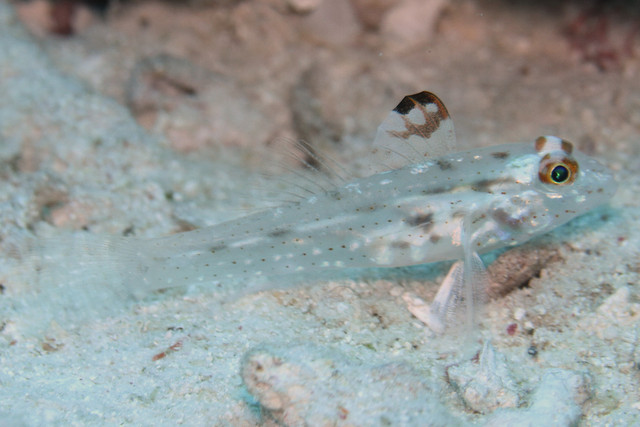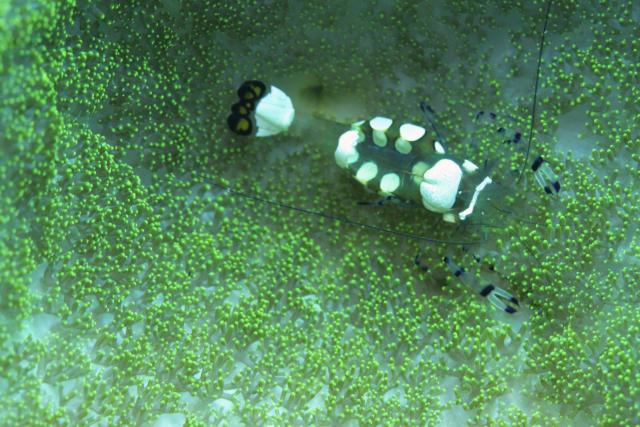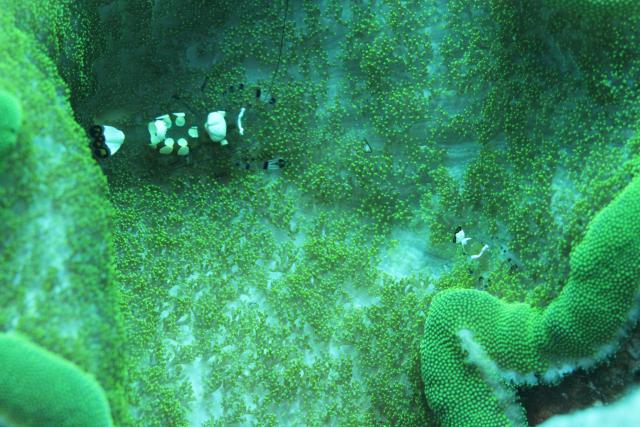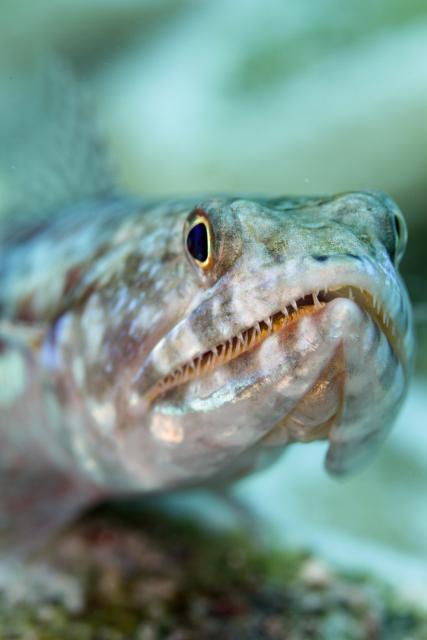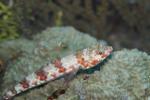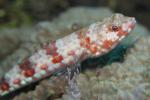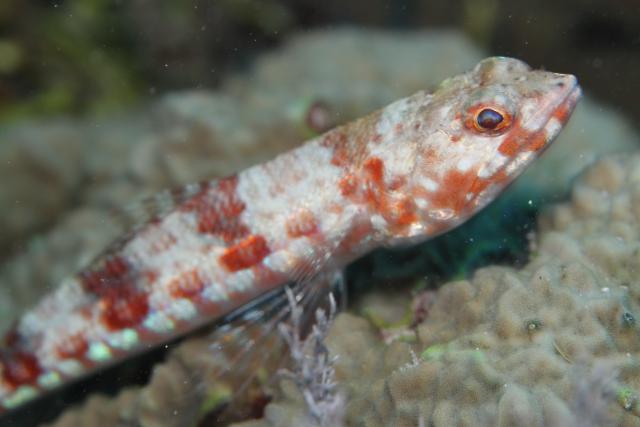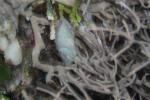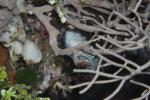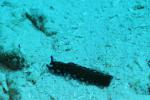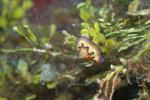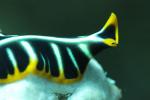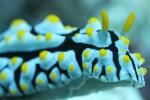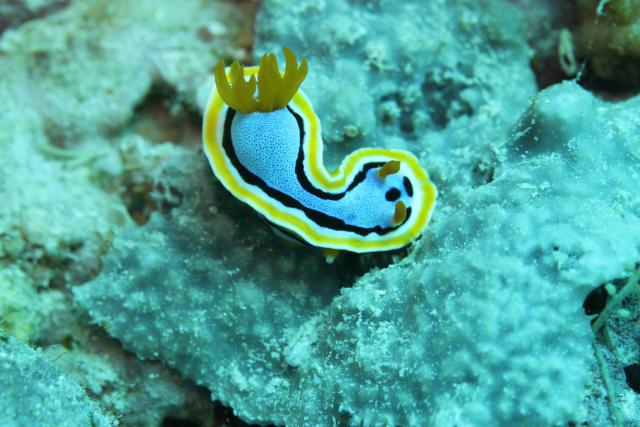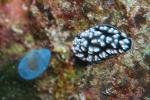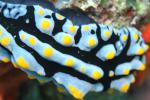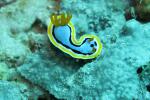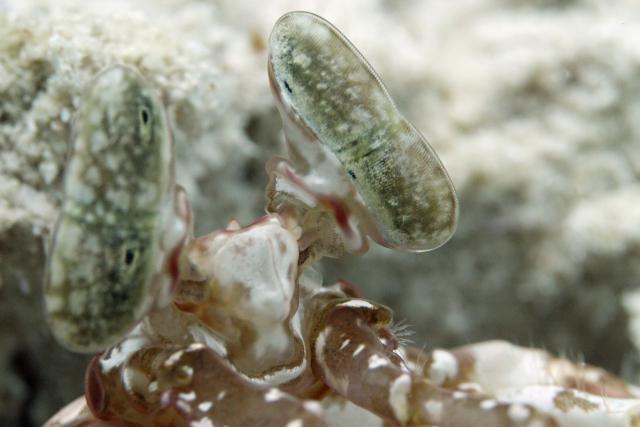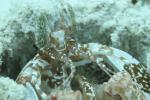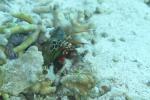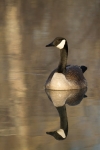underwater
Wakatobi: Signalfin Goby
ktuli — Tue, 05/17/2011 - 20:10
I was flipping through my Wakatobi shots again tonight, and I stumbled upon this one of a Signalfin Goby (Coryphopterus signipinnis).
These guys are fairly tiny little fish - maxing out at about 1.25" - and are extremely skittish. To be honest, I don't even remember taking this photo.
Technical Data: Canon EOS 7D, Canon EF 100mm f/2.8L Macro IS USM, 1/50th sec at f/8. Image Stabilization on. ISO 400 (Auto). Ikelite Housing and Port with Ikelite 161 Strobe in TTL Mode. Removed Color Cast, Adjust Brightness -50, Contrast +10 in Photoshop Elements 8.0 (mouseover for original).
I know the shot is extremely over-exposed with the semi-translucent body of the fish and the bright white sand of the reef, even with having pulled the brightness back in Photoshop, but I am pretty pleased with the crisp focus and clarity (something I struggled with on this trip) - especially for such a small skittish subject.
Drop me a line and let me know what you think of the shot, and of the post production work.
- Bill
Wakatobi: Peacock-tail Anemone Shrimp
ktuli — Sat, 05/14/2011 - 12:44
Sorry - I don't even remember what all I did this week that I didn't get any new posts in, but here's another one from the Wakatobi trip.
I know I shared a slightly different version of this shrimp before, but I figured I would also share this version (which coincidentally is hanging from our walls in an 8x10" format) that has had a little post production work done on it.
Anya spotted this little girl (yes, I know it is a female) early in the one dive, but for whatever reason, no one else in the group got to see it. As soon as she pointed it out to me (and I figured out what she was pointing to!) I moved in and rattled off a ton of shots.
Technical Data: Canon EOS 7D, Canon EF 100mm f/2.8L Macro IS USM, 1/100th sec at f/11.3. Image Stabilization on. ISO 3200 (Auto). Ikelite Housing and Port with Ikelite 161 Strobe in TTL Mode. Removed Color Cast in Photoshop Elements 8.0 (mouseover for original).
The Peacock-tail Anemone Shrimp (Periclimenes brevicarpalis) is only about 1.5" long and lives specifically on carpet anemones where in exchange for keeping the anemone free of parasites and potentially warning off some predators, it receives protection and free meals from the scraps the anemone misses. As I said, I know this is a female because they are much larger than the males - as you can see in the photo below (the male is towards the bottom right).
Technical Data: Canon EOS 7D, Canon EF 100mm f/2.8L Macro IS USM, 1/170th sec at f/11.3. Image Stabilization on. ISO 2500 (Auto). Ikelite Housing and Port with Ikelite 161 Strobe in TTL Mode. No post production.
Unfortunately, this was the only shrimp we saw like this, and any others we saw I didn't manage to get good photos of. Which is a shame, really, because I am very fond of shrimp - especially these tropical ornamental kinds.
- Bill
Wakatobi: Reef Lizardfish
ktuli — Mon, 05/09/2011 - 19:02
I've found myself thinking back to my Wakatobi trip a lot recently. I really long to be slowly sinking below the surface of some crystal clear blue water, camera in hand, ready to go find some interesting reef inhabitant.
We saw plenty of these Reef Lizardfish (Synodus variegatus) on almost every dive. Most were in the range of 8-10 inches in length and would sit motionless on top of outcroppings. In general, they would let you approach within a few feet of them before they darted off to hide, so getting relatively close like this was not too challenging as long as you moved in slowly.
As you can see, they had tons of sharp little curved teeth that despite being tiny were kind of impressively intimidating. That, coupled with their jaw structure illustrates that they are an ambush predator. They lie still waiting for an unsuspecting fish to swim a little too close, then - *WHAM!* - lunge forward with that large mouth, using those curved teeth (much like a lizard) to keep their prey from escaping.
Cool little fish.
Technical Data: Canon EOS 7D, Canon EF 100mm f/2.8L Macro IS USM, 1/170th sec at f/8. Image Stabilization on. ISO 500 (Auto). Ikelite Housing and Port with Ikelite 161 Strobe in TTL Mode. Auto-smartfix and Removed Color Cast in Photoshop Elements 8.0 (mouseover for original)
Why This Photo: As I said, I was quite impressed with those teeth, and they help to give the fish its lizard like namesake, so I wanted to capture a shot that showed those teeth in particular.
What Works: The focus is right on the fish's eye, and more importantly on those razor sharp teeth. The varying diagonal lines (the reef shelf, the lizard fish's back, its jawline, etc) continuously lead the viewer's eyes through the frame and back again.
What Doesn't Work: The aperture could have been stopped down just a little more (perhaps to f/11) for more depth of field to show more of the fish in focus - though just enough to keep the head in focus to avoid there being distracting elements to take away from the teeth being the main point of interest. Also, potentially a horizontal format would have worked better for this long fish.
As a bonus, I have several other shots of these fish to share... though, for some reason, I liked to cut off their tails from the shots. I don't know why, but looking through all of my lizardfish shots, they are pretty much all like that. Guess I'll have to go back and try it again... ;) Just mouseover the thumbnail to display the larger version.
And as you can see, I also apparently only approach these fish from their right sides... Weird. Anyway, what I was trying to illustrate was the variety in their colors... ranging from light tan, to dark brown, and even to a bright red.
Like I said, cool little fish.
- Bill
Wakatobi: Pair of Hawkfish
ktuli — Thu, 03/31/2011 - 20:20
Just stopping by to share a couple different hawkfish we encountered while diving in Wakatobi. Enjoy.
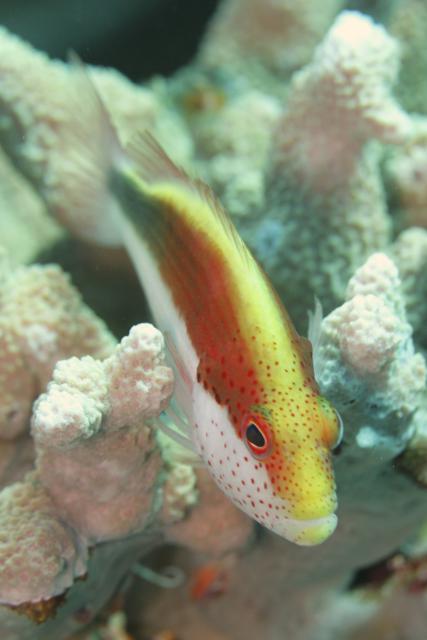
Freckled Hawkfish (Paracirrhites forsteri)
Technical Data: Canon EOS 7D, Canon EF 100mm f/2.8L Macro IS USM, 1/100th sec at f/8. Image Stabilization on. ISO 400 (Auto). Ikelite Housing and Port with Ikelite DS161 Strobe in TTL Mode. Remove color cast and cropped in Photoshop Elements 8.0.
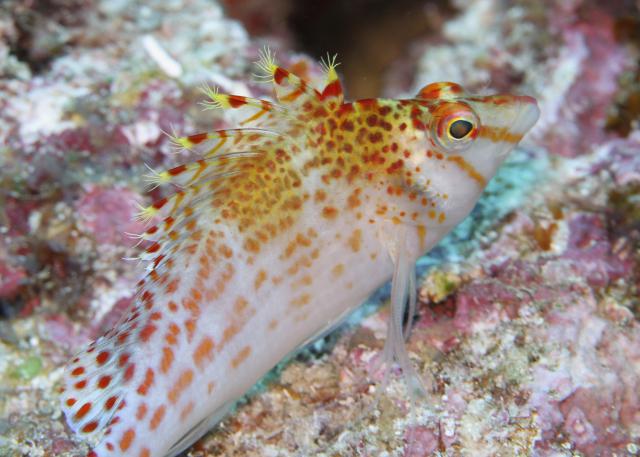
Dwarf Hawkfish (Cirrhitichthys falco)
Technical Data: Canon EOS 7D, Canon EF 100mm f/2.8L Macro IS USM, 1/40th sec at f/8. Image Stabilization on. ISO 400 (Auto). Ikelite Housing and Port with Ikelite DS161 Strobe in TTL Mode. Remove color cast and cropped in Photoshop Elements 8.0.
Some cool little fish, we saw plenty of them on the reefs - especially the dwarf hawkfish whose camouflage allows them to sit right out in the open.
- Bill
Wakatobi: Fire Dartfish
ktuli — Wed, 03/23/2011 - 20:59
Alright, back to the dive photography (how I wish that meant back to taking dive photos!) to try and get back into my routine of regular posts.
Today's little guy (or girl - can tell for certain what sex it is) is a Fire Dartfish (Nemateleotris magnifica). They are small (about three inches max) and very skittish, so getting close to fill this much of the frame with one is a bit of a challenge.
Technical Data: Canon EOS 7D, Canon EF 100mm f/2.8L Macro IS USM, 1/130th sec at f/8. Image Stabilization on. ISO 800 (Auto). Ikelite Housing and Port with Ikelite 161 Strobe in TTL Mode. Auto-smartfix and brightness reduced 10% in Photoshop Elements 8.0
What Works: The best part of this photo for me is how the fish jumps off the screen - there is just a three dimensionality to the shot that really pops! The colors of the dartfish are spot on, and the depth of field provides a nice soft background with just enough detail to show some of the liverock in the background.
What Doesn't Work: First, the dartfish itself is a bit washed out - those bright white scales are just so easily over-exposed. Additionally, the positioning of the fish in the frame is less than ideal with it looking out of the frame.
What do you think? Drop me a comment and let me know.
- Bill
Wakatobi: Cuttlefish!
ktuli — Sun, 02/27/2011 - 20:17
So one of the things that I really wanted to see while in Wakatobi was a cephalopod. So far on our two previous dive trips to Cozumel, we'd gotten close but my poor air consumption caused us to miss out. The first year, we were sitting on the boat for a good while before the rest of the group surfaced with stories of seeing multiple octopi. Last summer, the group all swarmed a small coral mound where an octopus was spotted, but my air was low and strong currents literally pulled Anya and I away from the opportunity.
For this trip, I was bound and determined to see some sort of cephalopod - an octopus, a squid, or possibly even a cuttlefish (I wasn't going to push my luck and expect to see a nautilus). The brochure for Wakatobi made it seem like we would see any (or all - except for the nautilus) of these critters on a majority of the dives.
The week started out semi-promising. The folks at the front of our group happened upon an octopus while it was feeding on a crab. Unfortunately for us, we were at the back of the group and he got scared off before we could get there. I saw a fleeting glimpse of something, but couldn't be certain of what I saw.
Then things went cold. Everyone in the group (including Mike - our instructor - who has more dives than anyone (including the dive-masters) and as seen just about everything) kept asking the dive-masters over and over for octopi or cuttlefish. The dive-masters subsequently gave us more and more desperate answers as to why we haven't seen them or that they aren't quite as common as we might have expected.
And then came our night dive - which I knew would be my best chance. I decided I wasn't surfacing until I saw something good - something really good. And I didn't care if that meant I had to swim from person to person in the group and steal air from their secondary regulator (interestingly enough called an octopus regulator) until I did.
Early in the dive, the group split into two; myself, Anya, Ferris, Bruce, and Vanessa went off in one direction, while the others went somewhere else (I still don't know how we got split up, or where they went). And things started out pretty promising as we saw a frogfish and a squat lobster (more on both of those at a later date). While both of those things are both cool, they're not cephalopods...
Then Vanessa started making quite the racket to get our attention - it is customary while diving to simply tap on your air tank (usually with something else metal) to make noise to get other divers' attentions. We quickly made our way over to where she was, and were rewarded with seeing this little guy...
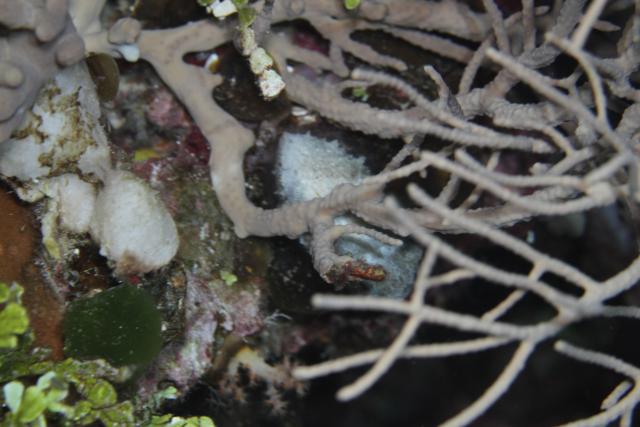
Technical Data: Canon EOS 7D, Canon EF 100mm f/2.8L Macro IS USM, 1/12th sec at f/8. Image Stabilization on. ISO 400 (Auto). Ikelite Housing and Port with Ikelite DS161 Strobe in TTL Mode. No post production.
Honestly, it took me a few seconds to realize what I was looking at - both out of sheer excitement and a bit of confusion from the strong camouflage. In the middle of both of those photos, there is a small white-ish cuttlefish. I apologize for the terrible photos - they're the best I got. It was dark, my pulse was racing, and I wanted to get some shots fired before it disappeared - which it did... only 7 seconds after we found it!
In the first shot, you can see the cuttlefish more exposed through the coral, but camera movement caused a terrible amount of ghosting. You can make out the main body and the large round eyes on the head, and the short tentacles curled up in front of the face. On the second shot, things are a bit more crisp (though still somewhat blurred) and shows a bit more of the skin texture (cuttlefish are able to change their skin texture at will for camouflage), but is more hidden behind the coral.
I'm not 100% sure, but the species might be a Crinoid Cuttlefish (Sepia sp. 2) or a baby Broadclub Cuttlefish (Sepia latimanus). The Crinoid species only get to about 2 inches full grown, whereas the Broadclub - the more common for this area - can grow to 20 inches. Either way - crinoid or baby - this little guy was quite the find! Certainly something fairly rare to see. And obviously, fairly hard to photograph.
Regardless, a mere seven seconds that I will remember for the rest of my life. I might not have captured the best photos with my camera, but I certainly recorded the image in my brain! Which is something that you need to remember to do as a photographer. Sometimes it is the photo that got away that we remember the best and means the most to us. Especially when it drives us to get out there and try for another...
... which I hope I get to do sooner rather than later.
- Bill
Wakatobi: Nudibranch & Flatworm Super Assortment
ktuli — Wed, 02/23/2011 - 21:07
As I said before, one of my favorite critters from Wakatobi were the nudibranchs and flatworms.
In rough terms, they both fall under what most people would call sea slugs. The main difference between the two are that nudibranchs have antennae called rhinophores and most have external gills, whereas flatworms do not have the rhinophores (though some like the Tiger Flatworm and Linda's Flatworm below adjust their head shape to fake them) nor any external gills.
Regardless, they're cool little things... take a look (mouseover the thumbnail for the larger view)
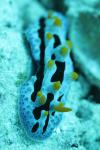 |
Sky Blue Phyllidia (Phyllidia coelestis) |
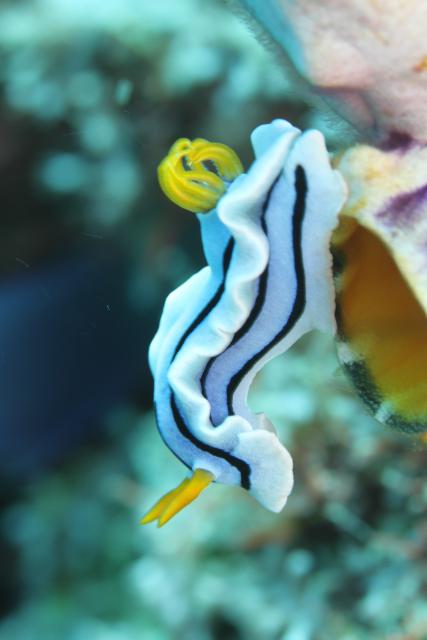 |
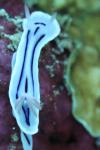 |
Willan's Chromodoris (Chromodoris willani) |
|
 |
Elisabeth's Chromodoris (Chromdoris elisabethina) |
|
 |
Racing Stripe Flatworm (Pseudoceros bifurcus) |
In reality, these are pretty tame looking nudibranchs, so I'm looking forward to another trip back to find more! I think if my count is correct, I photographed thirty-five different individuals (in nineteen dives!) consisting of four different species of flatworms and fifteen different species of nudibranchs.
So cool!
- Bill
Wakatobi: Blue Ribbon Eel
ktuli — Sat, 02/19/2011 - 09:30
As I mentioned yesterday, Roma was one of my favorite dive sites the entire week. Within 15 minutes of hitting the water, our diver masters had found us a Blue Ribbon Eel (Rhinomuraena quaesita), and the Tiger Mantis Shrimp I showed you yesterday.
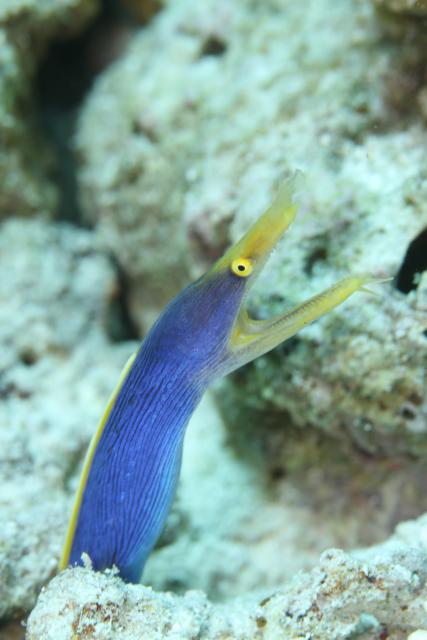 The Ribbon Eel was another critter on my wishlist, and since the brochure for Wakatobi "advertised" that we would see them, it was very nice to not be disappointed. In fact, reviewing the brochure now that we're home, we realize that we saw a majority of what was presented there.
The Ribbon Eel was another critter on my wishlist, and since the brochure for Wakatobi "advertised" that we would see them, it was very nice to not be disappointed. In fact, reviewing the brochure now that we're home, we realize that we saw a majority of what was presented there.
Technical Data: Canon EOS 7D, Canon EF 100mm f/2.8L Macro IS USM, 1/260th sec at f/8. Image Stabilization on. ISO 320 (Auto). Ikelite Housing and Port with Ikelite DS161 Strobe in TTL Mode. No post production.
Why This Photo: Well, let's see... I got certified to scuba dive, saved up for over a year, spent a bunch more for the camera equipment, traveled half-way around the world, all to get to see some of the wonderful creatures I'd only ever seen in nature documentaries and books. I guess I took this photo just 'cause I could.
What Works: The vertical format works well with this subject, and the diagonal line he produces through the shot provides a nice balance. Focus is tack sharp right on the eel's face, and its tiny razor sharp teeth are easily visible. The relatively shallow depth of field produces a softly defocused background to keep the eel as the main subject with minimal distraction.
What Doesn't Work: The black patch on the rock to the right of the eel is a bit distracting, a tighter crop would work better here. Also, the vantage point is still slightly above the eel, a lower vantage point would produce a more intimate image, and perhaps could have made the eel more comfortable with my presence (though I wasn't the only diver sticking a camera in its face!).
Of course, Mike, one of our dive instructors says he's been on dives and seen fields and fields of ribbon eels, but this guy was the first I've seen in person, so he is the coolest ribbon eel I've ever seen.
- Bill
Wakatobi: Mantis Shrimp
ktuli — Wed, 02/16/2011 - 20:18
What you see here are a pair of the most complex eyes known to man.
Technical Data: Canon EOS 7D, Canon EF 100mm f/2.8L Macro IS USM, 1/170th sec at f/8. Image Stabilization on. ISO 2500 (Auto). Ikelite Housing and Port with No Flash. Removed Color Cast and Auto-Smartfix in Photoshop Elements 8.0.
They belong to a Tiger Mantis Shrimp (Lysiosquillina maculata).
Mantis Shrimp (not related to either Praying Mantis nor Shrimp) were something I had on my checklist of things I wanted to see on this dive trip. And much like the nudibranchs, I was not expecting how often we would see them. I personally saw three individuals, plus evidence of at least two more, and others in the group saw several more individuals. This individual was seen at my personal favorite dive site at Wakatobi - Roma, which was also were my False Clownfish photo came from, and we also saw a Blue Ribbon Eel, a Leaf Scorpion Fish, Nudibranchs, Spine-cheek Anemonefish, Fire Dartfish, and tons more (but you'll have to stop back for those photos). If someone told me I could go back to Wakatobi and dive only one site the whole week, it would probably be Roma that I'd pick.
Anyway, you might be asking why those eyes are the most complex known to man. If you're not, you read that article I linked up there, and actually understood it all (I certainly didn't!). But the short story is this: they can see a much wider spectrum of light from us (spanning from infra-red all the way into the ultra-violet spectrum!), meaning they can see about ten times the number of colors we can, they can see and filter linear polarized light (we need sunglasses or camera lens filters for that), and some species can even see circular polarized light (also a job for lens filters), and additionally they do not lose depth perception when using only one eye (humans need both eyes for depth perception). Oh yeah, and they rotate independently, stick out from the head (ie: can see around corners), and if my research is correct, can pick up satellite television. Ok, maybe not that last bit, but they're still pretty impressive eyes. Then again, perhaps it isn't as much of an exaggeration after all - an article on Wired.com discusses how the Mantis Shrimp's eyes are being researched to help develop the next new High-Def recording medium (and I haven't even started switching to Blu-ray, and they're obsolete!).
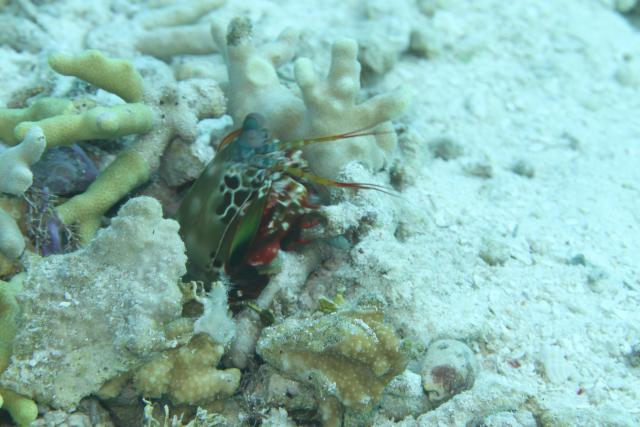
The last guy there is a Peacock Mantis Shrimp (Odontodactylus scyllarus) and is probably considered the more common mantis shrimp. They are sometimes available in the pet trade (and sometimes come into a tank as an unexpected hitchhiker on coral or live rock). They are much more colorful, thus their names.
In fact, I get to take credit for finding that guy on that particular dive (which was at a site called 'The Zoo'). I saw his burrow from about twenty feet away, and quickly made my way there. As I got close, I thought I had seen something duck inside, so I glanced into the hole (literally just a hole in the ground that drops about a foot deep, then branches off to the side) but didn't see anything. So I settled in on the sand and waited and watched. After a few minutes, Brigette (one of our dive instructors) came over and tapped me on the shoulder - which made me jump (I will explain why shortly). She asked what I was looking at, and I tried to explain that I wasn't quite sure if there was anything there or not. But she settled in next to me to wait too. No more than a few seconds later, the Peacock Mantis Shrimp returned to the top of his burrow and did some housekeeping, throwing a piece of broken coral out. I fired off a few frames. I was thrilled, but running low on air, so I passed the camera off to Anya and tried to indicate to her what I had been watching and to get some photos. I must have done a terrible job of explaining what it was, because she said she went over and was looking right down the burrow and trying to figure out what she was supposed to take photos of. Perhaps it was good that she didn't see the Mantis Shrimp, because he probably wouldn't have been thrilled with her getting so close to his burrow.

So why did I jump when Brigette tapped me on the shoulder? Well, as I lay there on the sand staring at this empty hole in the ground, the thought was occurring to me that perhaps the reason it was empty was because the occupant wasn't home. Peacock Mantis Shrimp are roaming hunters, and when they're out of their burrows, they look like the guy to the right (kind of alien, huh?) (Sorry, I did not take that photo - all of the mantis shrimp I saw were in their burrows.)
Still wondering why I might jump? Ok, let me add that some mantis shrimp can grow to 18 inches long! Still not convinced? Let's throw in their hunting styles. There are two styles of mantis shrimp, smashers and spearers. Smashers obviously, as the name implies, simply smash their prey to death; whereas spearers resemble praying mantids more in that they have back-folding raptorial arms they use to impale and hold prey. Still holding out on me, thinking I am a bit too jumpy? How about if I tell you that their attacks have the speed of a .22 caliber bullet - plus are supposed to be able to cause cavitation (causing a voided space in the water, which is then filled, causing a shockwave impact). Having owned a pet store for several years, mantis shrimp were referred to as 'thumb smashers' (I never carried them in my store, but often saw them at distributors). In general, they're nasty little guys. They have the strength to break crab shells, fingers, aquarium glass, and even camera housing lens ports!
Even with all of that, they're still fascinating creatures, and I was thrilled to get to see two different species of them in the wild in their environment, and to bring back photos of both. I look forward to getting even better shots next time!
- Bill
Wakatobi: House Reef Assortment
ktuli — Tue, 02/15/2011 - 19:44
Ok - I'll skip all the blabbering today. Instead I'll just give a nice little assortment of some of the absolutely incredible stuff we got to see just stepping off the beach and diving on Wakatobi's house reef.

Banded Sea Snake (Laticauda colubrina)
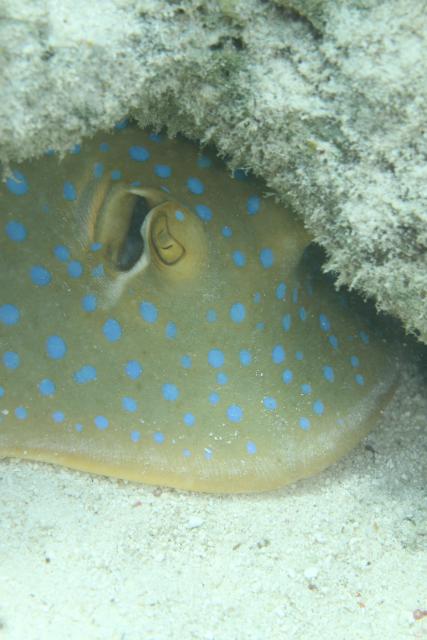
Blue-Spotted Ribbontail Ray (Taeniura lymma)

Crocodile Flathead (Cymbacephalus beauforti)
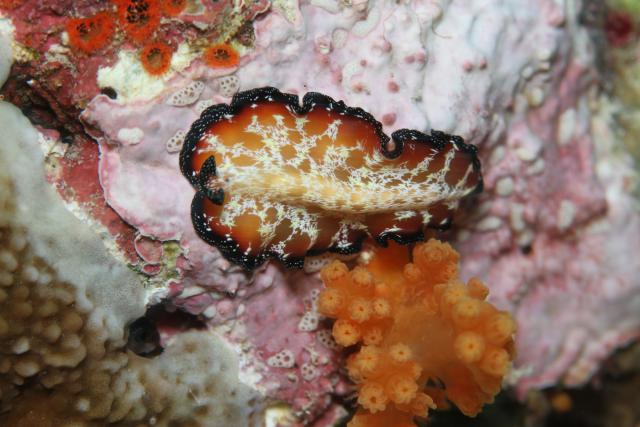
Lightning Flatworm (Pseudobiceros fulgor)
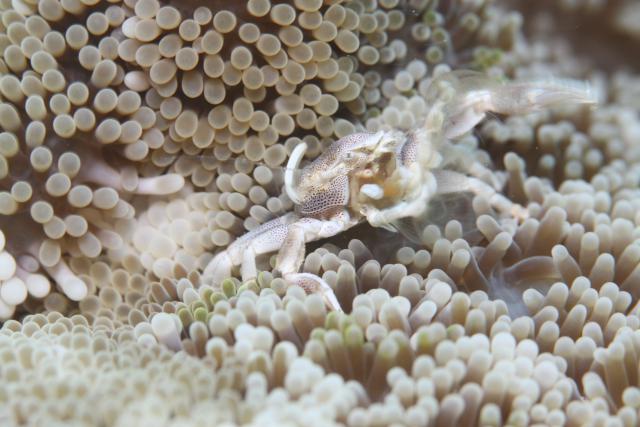
Spiny Porcelain Crab (Neopetrolisthes spinatus)

Twinspot (sometimes also Fu Manchu in the pet trade) Lionfish (Dendrochirus biocellatus)
I wish we had had another week that we could have spent just diving the house reef over and over. Perhaps next time!
- Bill

